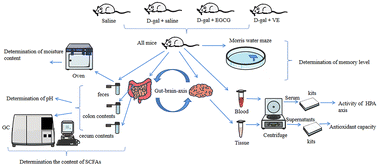Epigallocatechin-3-gallate alleviates galactose-induced aging impairment via gut–brain communication
Abstract
The study aimed to determine whether gut–brain communication could be modulated by epigallocatechin-3-gallate (EGCG) in a mouse aging model that was established by daily injection of D-galactose (D-gal) for 10 weeks. Our results showed that EGCG could improve aging-associated changes by increasing the immune organ indexes, brain index, and learning and memory ability in vivo. EGCG-triggered aging prevention was associated with the reduction of lipid peroxidation and elevation of enzymatic and non-enzymatic antioxidant activities in the brain. Concomitantly, treatment of D-gal-induced aging in mice with EGCG significantly reduced corticotropin-releasing hormone, adrenocorticotropic hormone, and corticosterone, suggesting that EGCG-exerted protection of the aging brain was involved in the inhibition of the hypothalamic–pituitary–adrenal (HPA) axis. Further data concerning intestinal function showed that EGCG could enhance fecal moisture in vitro and reduce the pH value of feces in aging mice when compared to the D-gal group, suggesting that EGCG played beneficial roles in the intestine of aging mice. Moreover, short-chain fatty acids (SCFAs), the mediators of gut–brain communication, were significantly increased in the intestinal contents of aging mice by treatment with EGCG. Therefore, the tea polyphenol EGCG showing anti-aging properties was demonstrated to be implicated in modulating gut–brain communication by attenuating the HPA axis and enhancing the content of SCFAs.



 Please wait while we load your content...
Please wait while we load your content...